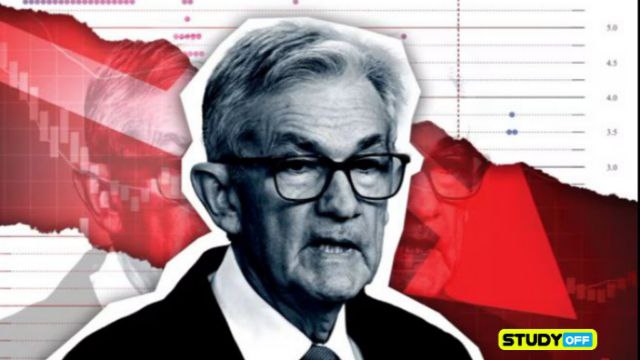Business News
aapl stock, cpi report, crypto news, ecb rate cut, fed interest rate, fed meeting, fed meeting june 2024, fed meeting schedule, fed meeting schedule 2024, fed rate, fed rate cuts, federal reserve interest rates fed meeting today when is the next fed meeting fed decision fed interest rate decision today fed rate meeting next fomc meeting, federal reserve meeting, fomc, fomc meeting, fomc meeting schedule, fomc meetings 2024, perplexing, rate cuts, unemployment rate
Soumen Samanta
0 Comments
Why is the Fed’s dot plot significant, and what does it entail?
This graph shows the direction that Fed insiders believe interest rates will go.
Contents
Important lessons learned
The important federal funds rate, as seen by top Fed policymakers, is depicted visually in the dot plot.
Since 2012, the Fed has released the dot plot on a quarterly basis as part of its transparency initiative.
As of right now, the dot plot indicates that the fed funds rate will start to fall towards the end of this year and then level off in 2025.
When do interest rates start to decline? The dot plot created by the Federal Reserve contains a crucial hint.
What is the dot plot of the Fed?
The Fed’s dot plot is a quarterly graphic that illustrates the projected interest rate levels for each member of the policymaking committee at the Fed.
This is significant because the federal funds rate—the country’s benchmark interest rate—is set by the Federal Reserve. This interest rate has an impact on rates for consumers, businesses, and investors, both directly and indirectly.
The Federal Reserve utilises the federal funds rate as one of its tools to fulfil its “dual mandate” of low inflation and low unemployment. An increase in interest rates tends to chill the economy and reduce inflation, but it also increases the chance of unemployment. Lowering rates, on the other hand, often encourages investment and expenditure in the economy, which lowers unemployment but increases the possibility of inflation. It requires careful balancing.
The Fed releases the dot plot every quarter as part of its Summary of Economic Projections, coinciding with its December, March, June, and September meetings, to aid the public in understanding its thinking. Check it out for yourself by going to the FOMC meeting schedule.
How would one interpret the Fed’s dot plot?
It is easy to read the Fed’s dot plot on its own. To help you navigate it, here is an annotated replica of the March 2024 dot plot:
Source: March 2024 Summary of Economic Projections from the Federal Reserve Board
What is seen in the chart:
Vertical (Y) axis: The federal funds rate target percentage.
X-ray horizontal axis: This displays the next two calendar years in addition to the current year and the “longer run.” Expectations for the year’s end are stated for each year. A “neutral” interest rate—one that would neither heat up nor cool down the economy—is estimated in the “longer run” column.
The points: One dot in each column denotes the outlook of one member of the Open Market Committee, which sets policy for the Federal Reserve Board. The dot would be positioned halfway between those marks if the person anticipates that the target range will be 4.25–4.50% at the end of the year.
What meaning does the Fed assign to the dot plot?
Now that you know what to look for, try interpreting the Fed’s dot plot by keeping an eye out for the following:
Patterns: You may see a general indication of the path that officials believe interest rates will take in the next years.
Clusters: Although there are frequently anomalies, the policymakers’ consensus may be seen where the dots cluster.
To what extent does the Fed’s dot plot alter?
Recall that the dot plot shows the Fed’s policymakers’ best estimates of where interest rates will be several months or years ahead of time. As the goal date approaches and the clarity of the economic data increases, these best estimates are sure to change.
Take a look at the changes that the December 2024 dot plot has undergone in the last two years. In an effort to fight inflation, the Fed started hiking rates in March 2022. It was forecasting rates for December 2024 at the same time.
As you can see, expectations spiked and then levelled off. The dots have begun to cluster around 4.5–5.0% during the last two quarters.
Why is the dot plot of the Fed changing?
The Fed’s dot plot varies when decision-makers modify their expectations for the necessary interest rate hikes or decreases to maintain low inflation and high employment. Four important economic variables are closely monitored by policymakers while creating these estimates.
Real gross domestic product change: When the effects of inflation are taken into account, this illustrates how much the economy is rising.
Rate of unemployment: The Fed has no fixed objective for unemployment, but one of its duties is to attempt to maintain it low. It also serves as a timely and helpful gauge of the economy’s general health.
PCE inflation: One method of calculating inflation is to use the Personal Consumption Expenditures price index. The Consumer Price Index tracks changes in the prices of a specified basket of goods and services and is commonly used to refer to inflation. The PCE records variations in household expenditure. For instance, the CPI may indicate that the cost of steak is rising, but it does not account for the impact of customers moving to hamburgers in order to reduce their grocery expenses. Conversely, PCE records the shift in the real amount of money that people are spending.
“Core” inflation of PCE: Food and energy prices are excluded from “core” inflation rates, not because they are unimportant to consumers, but rather because of how erratic their prices can be. It illustrates the extent to which inflation is ingrained throughout the economy.
The policymakers at the Federal Reserve project the positions of these four indicators for the upcoming few years, as part of their quarterly Summary of Economic Projections. Should they diverge from forecasts, future expectations for interest rates may also alter.
The range of predictions for these indicators by the end of 2024 is depicted in the following chart:
The estimates are based on the March 2024 Summary of Economic Projections and represent an average for Q4 2024. The most recent figures are as follows: US Bureau of Labour Statistics’ April unemployment rate; Bureau of Economic Analysis’s annualised growth rate for the GDP; Bureau of Economic Analysis’s PCE and Core PCE for March’s year-over-year percent change.
Why it matters: The Fed’s dot plot
The federal funds rate has always had an impact on the market. However, until 1997, they were frequently unexpected. The Federal Reserve didn’t admit that its primary policy instrument was a goal for the federal funds rate until August 1997. Since then, it has gradually increased the transparency of its policy goals and considerations, so the market isn’t likely to be much surprised.
As part of this push for transparency, the Fed has been publishing the dot plot since 2012, and the market now analyses the dot plot for cues and indicators. It is seldom caught off guard.
Read More:
Check out our most recent Federal Reserve piece or read more market insights to stay up to date on the most recent interest rate news from Fidelity Viewpoints.




Post Comment